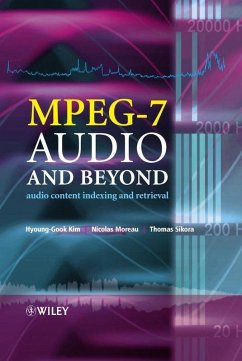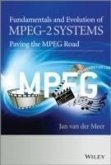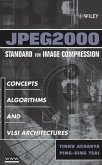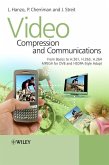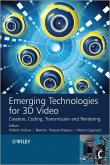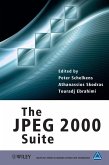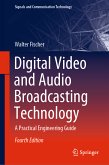Hyoung-Gook Kim, Nicolas Moreau, Thomas Sikora
MPEG-7 Audio and Beyond (eBook, PDF)
Audio Content Indexing and Retrieval
114,99 €
114,99 €
inkl. MwSt.
Sofort per Download lieferbar

0 °P sammeln
114,99 €
Als Download kaufen

114,99 €
inkl. MwSt.
Sofort per Download lieferbar

0 °P sammeln
Jetzt verschenken
Alle Infos zum eBook verschenken
114,99 €
inkl. MwSt.
Sofort per Download lieferbar
Alle Infos zum eBook verschenken

0 °P sammeln
Hyoung-Gook Kim, Nicolas Moreau, Thomas Sikora
MPEG-7 Audio and Beyond (eBook, PDF)
Audio Content Indexing and Retrieval
- Format: PDF
- Merkliste
- Auf die Merkliste
- Bewerten Bewerten
- Teilen
- Produkt teilen
- Produkterinnerung
- Produkterinnerung

Bitte loggen Sie sich zunächst in Ihr Kundenkonto ein oder registrieren Sie sich bei
bücher.de, um das eBook-Abo tolino select nutzen zu können.
Hier können Sie sich einloggen
Hier können Sie sich einloggen
Sie sind bereits eingeloggt. Klicken Sie auf 2. tolino select Abo, um fortzufahren.

Bitte loggen Sie sich zunächst in Ihr Kundenkonto ein oder registrieren Sie sich bei bücher.de, um das eBook-Abo tolino select nutzen zu können.
Advances in technology, such as MP3 players, the Internet and DVDs, have led to the production, storage and distribution of a wealth of audio signals, including speech, music and more general sound signals and their combinations. MPEG-7 audio tools were created to enable the navigation of this data, by providing an established framework for effective multimedia management. MPEG-7 Audio and Beyond: Audio Content Indexing and Retrieval is a unique insight into the technology, covering the following topics: * the fundamentals of MPEG-7 audio, principally low-level descriptors and sound…mehr
- Geräte: PC
- mit Kopierschutz
- eBook Hilfe
- Größe: 3.89MB
Andere Kunden interessierten sich auch für
![The Handbook of MPEG Applications (eBook, PDF) The Handbook of MPEG Applications (eBook, PDF)]() The Handbook of MPEG Applications (eBook, PDF)98,99 €
The Handbook of MPEG Applications (eBook, PDF)98,99 €![Fundamentals and Evolution of MPEG-2 Systems (eBook, PDF) Fundamentals and Evolution of MPEG-2 Systems (eBook, PDF)]() Jan Van Der MeerFundamentals and Evolution of MPEG-2 Systems (eBook, PDF)90,99 €
Jan Van Der MeerFundamentals and Evolution of MPEG-2 Systems (eBook, PDF)90,99 €![JPEG2000 Standard for Image Compression (eBook, PDF) JPEG2000 Standard for Image Compression (eBook, PDF)]() Tinku AcharyaJPEG2000 Standard for Image Compression (eBook, PDF)98,99 €
Tinku AcharyaJPEG2000 Standard for Image Compression (eBook, PDF)98,99 €![Video Compression and Communications (eBook, PDF) Video Compression and Communications (eBook, PDF)]() Lajos HanzoVideo Compression and Communications (eBook, PDF)163,99 €
Lajos HanzoVideo Compression and Communications (eBook, PDF)163,99 €![Emerging Technologies for 3D Video (eBook, PDF) Emerging Technologies for 3D Video (eBook, PDF)]() Frederic DufauxEmerging Technologies for 3D Video (eBook, PDF)103,99 €
Frederic DufauxEmerging Technologies for 3D Video (eBook, PDF)103,99 €![The JPEG 2000 Suite (eBook, PDF) The JPEG 2000 Suite (eBook, PDF)]() The JPEG 2000 Suite (eBook, PDF)121,99 €
The JPEG 2000 Suite (eBook, PDF)121,99 €![Digital Video and Audio Broadcasting Technology (eBook, PDF) Digital Video and Audio Broadcasting Technology (eBook, PDF)]() Walter FischerDigital Video and Audio Broadcasting Technology (eBook, PDF)88,95 €
Walter FischerDigital Video and Audio Broadcasting Technology (eBook, PDF)88,95 €-
-
-
Advances in technology, such as MP3 players, the Internet and DVDs, have led to the production, storage and distribution of a wealth of audio signals, including speech, music and more general sound signals and their combinations. MPEG-7 audio tools were created to enable the navigation of this data, by providing an established framework for effective multimedia management. MPEG-7 Audio and Beyond: Audio Content Indexing and Retrieval is a unique insight into the technology, covering the following topics: * the fundamentals of MPEG-7 audio, principally low-level descriptors and sound classification and similarity; * spoken content description, and timbre, melody and tempo music description tools; * existing MPEG-7 applications and those currently being developed; * examples of audio technology beyond the scope of MPEG-7. Essential reading for practising electronic and communications engineers designing and implementing MPEG-7 compliant systems, this book will also be a useful reference for researchers and graduate students working with multimedia database technology.
Dieser Download kann aus rechtlichen Gründen nur mit Rechnungsadresse in D ausgeliefert werden.
Produktdetails
- Produktdetails
- Verlag: John Wiley & Sons
- Erscheinungstermin: 3. Februar 2006
- Englisch
- ISBN-13: 9780470093351
- Artikelnr.: 37290516
- Verlag: John Wiley & Sons
- Erscheinungstermin: 3. Februar 2006
- Englisch
- ISBN-13: 9780470093351
- Artikelnr.: 37290516
- Herstellerkennzeichnung Die Herstellerinformationen sind derzeit nicht verfügbar.
Hyoung-Gook Kim, Researcher of the MPEG-7 Audio Project at the Communication Systems Group, Technical University of Berlin, Communication Systems Group, Sekr. EN 1, Einsteinufer 17, D-10587 Berlin
Nicolas Moreau, Researcher of the MPEG-7 Audio Project at the Communication Systems Group, Technical University of Berlin, Communication Systems Group, Sekr. EN 1, Einsteinufer 17, D-10587 Berlin
Thomas Sikora, Professor and head of the Communication Systems Group, Technical University of Berlin, Communication Systems Group, Sekr. EN 1, Einsteinufer 17, D-10587 Berlin
Nicolas Moreau, Researcher of the MPEG-7 Audio Project at the Communication Systems Group, Technical University of Berlin, Communication Systems Group, Sekr. EN 1, Einsteinufer 17, D-10587 Berlin
Thomas Sikora, Professor and head of the Communication Systems Group, Technical University of Berlin, Communication Systems Group, Sekr. EN 1, Einsteinufer 17, D-10587 Berlin
List of Acronyms.
List of Symbols.
1. Introduction.
1.1 Audio Content Description.
1.2 MPEG-7 Audio Content Description - An Overview.
1.2.1 MPEG-7 Low-Level Descriptors.
1.2.2 MPEG-7 Description Schemes.
1.2.3 MPEG-7 Description Definition Language (DDL).
1.2.4 BiM (Binary Format for MPEG-7).
1.3 Organization of the Book.
2. Low-Level Descriptors.
2.1 Introduction.
2.2 Basic Parameters and Notations.
2.2.1 Time Domain.
2.2.2 Frequency Domain.
2.3 Scalable Series.
2.3.1 Series of Scalars.
2.3.2 Series of Vectors.
2.3.3 Binary Series.
2.4 Basic Descriptors.
2.4.1 Audio Waveform.
2.4.2 Audio Power.
2.5 Basic Spectral Descriptors.
2.5.1 Audio Spectrum Envelope.
2.5.2 Audio Spectrum Centroid.
2.5.3 Audio Spectrum Spread.
2.5.4 Audio Spectrum Flatness.
2.6 Basic Signal Parameters.
2.6.1 Audio Harmonicity.
2.6.2 Audio Fundamental Frequency.
2.7 Timbral Descriptors.
2.7.1 Temporal Timbral: Requirements.
2.7.2 Log Attack Time.
2.7.3 Temporal Centroid.
2.7.4 Spectral Timbral: Requirements.
2.7.5 Harmonic Spectral Centroid.
2.7.6 Harmonic Spectral Deviation.
2.7.7 Harmonic Spectral Spread.
2.7.8 Harmonic Spectral Variation.
2.7.9 Spectral Centroid.
2.8 Spectral Basis Representations.
2.9 Silence Segment.
2.10 Beyond the Scope of MPEG-7.
2.10.1 Other Low-Level Descriptors.
2.10.2 Mel-Frequency Cepstrum Coefficients.
References.
3. Sound Classification and Similarity.
3.1 Introduction.
3.2 Dimensionality Reduction.
3.2.1 Singular Value Decomposition (SVD).
3.2.2 Principal Component Analysis (PCA).
3.2.3 Independent Component Analysis (ICA).
3.2.4 Non-Negative Factorization (NMF).
3.3 Classification Methods.
3.3.1 Gaussian Mixture Model (GMM).
3.3.2 Hidden Markov Model (HMM).
3.3.3 Neural Network (NN).
3.3.4 Support Vector Machine (SVM).
3.4 MPEG-7 Sound Classification.
3.4.1 MPEG-7 Audio Spectrum Projection (ASP) Feature Extraction.
3.4.2 Training Hidden Markov Models (HMMs).
3.4.3 Classification of Sounds.
3.5 Comparison of MPEG-7 Audio Spectrum Projection vs. MFCC Features.
3.6 Indexing and Similarity.
3.6.1 Audio Retrieval Using Histogram Sum of Squared Differences.
3.7 Simulation Results and Discussion.
3.7.1 Plots of MPEG-7 Audio Descriptors.
3.7.2 Parameter Selection.
3.7.3 Results for Distinguishing Between Speech, Music and Environmental
Sound.
3.7.4 Results of Sound Classification Using Three Audio Taxonomy Methods.
3.7.5 Results for Speaker Recognition.
3.7.6 Results of Musical Instrument Classification.
3.7.7 Audio Retrieval Results.
3.8 Conclusions.
References.
4. Spoken Content.
4.1 Introduction.
4.2 Automatic Speech Recognition.
4.2.1 Basic Principles.
4.2.2 Types of Speech Recognition Systems.
4.2.3 Recognition Results.
4.3 MPEG-7 SpokenContent Description.
4.3.1 General Structure.
4.3.2 SpokenContentHeader.
4.3.3 SpokenContentLattice.
4.4 Application: Spoken Document Retrieval.
4.4.1 Basic Principles of IR and SDR.
4.4.2 Vector Space Models.
4.4.3 Word-Based SDR.
4.4.4 Sub-Word-Based Vector Space Models.
4.4.5 Sub-Word String Matching.
4.4.6 Combining Word and Sub-Word Indexing.
4.5 Conclusions.
4.5.1 MPEG-7 Interoperability.
4.5.2 MPEG-7 Flexibility.
4.5.3 Perspectives.
References.
5. Music Description Tools.
5.1 Timbre.
5.1.1 Introduction.
5.1.2 InstrumentTimbre.
5.1.3 HarmonicInstrumentTimbre.
5.1.4 PercussiveInstrumentTimbre.
5.1.5 Distance Measures.
5.2 Melody.
5.2.1 Melody.
5.2.2 Meter.
5.2.3 Scale.
5.2.4 Key.
5.2.5 MelodyContour.
5.2.6 MelodySequence.
5.3 Tempo.
5.3.1 AudioTempo.
5.3.2 AudioBPM.
5.4 Application Example: Query-by-Humming.
5.4.1 Monophonic Melody Transcription.
5.4.2 Polyphonic Melody Transcription.
5.4.3 Comparison of Melody Contours.
References.
6. Fingerprinting and Audio Signal Quality.
6.1 Introduction.
6.2 Audio Signature.
6.2.1 Generalities on Audio Fingerprinting.
6.2.2 Fingerprint Extraction.
6.2.3 Distance and Searching Methods.
6.2.4 MPEG-7-Standardized AudioSignature.
6.3 Audio Signal Quality.
6.3.1 AudioSignalQuality Description Scheme.
6.3.2 BroadcastReady.
6.3.3 IsOriginalMono.
6.3.4 BackgroundNoiseLevel.
6.3.5 CrossChannelCorrelation.
6.3.6 RelativeDelay.
6.3.7 Balance.
6.3.8 DcOffset.
6.3.9 Bandwidth.
6.3.10 TransmissionTechnology.
6.3.11 ErrorEvent and ErrorEventList.
References.
7. Application.
7.1 Introduction.
7.2 Automatic Audio Segmentation.
7.2.1 Feature Extraction.
7.2.2 Segmentation.
7.2.3 Metric-Based Segmentation.
7.2.4 Model-Selection-Based Segmentation.
7.2.5 Hybrid Segmentation.
7.2.6 Hybrid Segmentation Using MPEG-7 ASP.
7.2.7 Segmentation Results.
7.3 Sound Indexing and Browsing of Home Video Using Spoken Annotations.
7.3.1 A Simple Experimental System.
7.3.2 Retrieval Results.
7.4 Highlights Extraction for Sport Programmes Using Audio Event Detection.
7.4.1 Goal Event Segment Selection.
7.4.2 System Results.
7.5 A Spoken Document Retrieval System for Digital Photo Albums.
References.
Index.
List of Symbols.
1. Introduction.
1.1 Audio Content Description.
1.2 MPEG-7 Audio Content Description - An Overview.
1.2.1 MPEG-7 Low-Level Descriptors.
1.2.2 MPEG-7 Description Schemes.
1.2.3 MPEG-7 Description Definition Language (DDL).
1.2.4 BiM (Binary Format for MPEG-7).
1.3 Organization of the Book.
2. Low-Level Descriptors.
2.1 Introduction.
2.2 Basic Parameters and Notations.
2.2.1 Time Domain.
2.2.2 Frequency Domain.
2.3 Scalable Series.
2.3.1 Series of Scalars.
2.3.2 Series of Vectors.
2.3.3 Binary Series.
2.4 Basic Descriptors.
2.4.1 Audio Waveform.
2.4.2 Audio Power.
2.5 Basic Spectral Descriptors.
2.5.1 Audio Spectrum Envelope.
2.5.2 Audio Spectrum Centroid.
2.5.3 Audio Spectrum Spread.
2.5.4 Audio Spectrum Flatness.
2.6 Basic Signal Parameters.
2.6.1 Audio Harmonicity.
2.6.2 Audio Fundamental Frequency.
2.7 Timbral Descriptors.
2.7.1 Temporal Timbral: Requirements.
2.7.2 Log Attack Time.
2.7.3 Temporal Centroid.
2.7.4 Spectral Timbral: Requirements.
2.7.5 Harmonic Spectral Centroid.
2.7.6 Harmonic Spectral Deviation.
2.7.7 Harmonic Spectral Spread.
2.7.8 Harmonic Spectral Variation.
2.7.9 Spectral Centroid.
2.8 Spectral Basis Representations.
2.9 Silence Segment.
2.10 Beyond the Scope of MPEG-7.
2.10.1 Other Low-Level Descriptors.
2.10.2 Mel-Frequency Cepstrum Coefficients.
References.
3. Sound Classification and Similarity.
3.1 Introduction.
3.2 Dimensionality Reduction.
3.2.1 Singular Value Decomposition (SVD).
3.2.2 Principal Component Analysis (PCA).
3.2.3 Independent Component Analysis (ICA).
3.2.4 Non-Negative Factorization (NMF).
3.3 Classification Methods.
3.3.1 Gaussian Mixture Model (GMM).
3.3.2 Hidden Markov Model (HMM).
3.3.3 Neural Network (NN).
3.3.4 Support Vector Machine (SVM).
3.4 MPEG-7 Sound Classification.
3.4.1 MPEG-7 Audio Spectrum Projection (ASP) Feature Extraction.
3.4.2 Training Hidden Markov Models (HMMs).
3.4.3 Classification of Sounds.
3.5 Comparison of MPEG-7 Audio Spectrum Projection vs. MFCC Features.
3.6 Indexing and Similarity.
3.6.1 Audio Retrieval Using Histogram Sum of Squared Differences.
3.7 Simulation Results and Discussion.
3.7.1 Plots of MPEG-7 Audio Descriptors.
3.7.2 Parameter Selection.
3.7.3 Results for Distinguishing Between Speech, Music and Environmental
Sound.
3.7.4 Results of Sound Classification Using Three Audio Taxonomy Methods.
3.7.5 Results for Speaker Recognition.
3.7.6 Results of Musical Instrument Classification.
3.7.7 Audio Retrieval Results.
3.8 Conclusions.
References.
4. Spoken Content.
4.1 Introduction.
4.2 Automatic Speech Recognition.
4.2.1 Basic Principles.
4.2.2 Types of Speech Recognition Systems.
4.2.3 Recognition Results.
4.3 MPEG-7 SpokenContent Description.
4.3.1 General Structure.
4.3.2 SpokenContentHeader.
4.3.3 SpokenContentLattice.
4.4 Application: Spoken Document Retrieval.
4.4.1 Basic Principles of IR and SDR.
4.4.2 Vector Space Models.
4.4.3 Word-Based SDR.
4.4.4 Sub-Word-Based Vector Space Models.
4.4.5 Sub-Word String Matching.
4.4.6 Combining Word and Sub-Word Indexing.
4.5 Conclusions.
4.5.1 MPEG-7 Interoperability.
4.5.2 MPEG-7 Flexibility.
4.5.3 Perspectives.
References.
5. Music Description Tools.
5.1 Timbre.
5.1.1 Introduction.
5.1.2 InstrumentTimbre.
5.1.3 HarmonicInstrumentTimbre.
5.1.4 PercussiveInstrumentTimbre.
5.1.5 Distance Measures.
5.2 Melody.
5.2.1 Melody.
5.2.2 Meter.
5.2.3 Scale.
5.2.4 Key.
5.2.5 MelodyContour.
5.2.6 MelodySequence.
5.3 Tempo.
5.3.1 AudioTempo.
5.3.2 AudioBPM.
5.4 Application Example: Query-by-Humming.
5.4.1 Monophonic Melody Transcription.
5.4.2 Polyphonic Melody Transcription.
5.4.3 Comparison of Melody Contours.
References.
6. Fingerprinting and Audio Signal Quality.
6.1 Introduction.
6.2 Audio Signature.
6.2.1 Generalities on Audio Fingerprinting.
6.2.2 Fingerprint Extraction.
6.2.3 Distance and Searching Methods.
6.2.4 MPEG-7-Standardized AudioSignature.
6.3 Audio Signal Quality.
6.3.1 AudioSignalQuality Description Scheme.
6.3.2 BroadcastReady.
6.3.3 IsOriginalMono.
6.3.4 BackgroundNoiseLevel.
6.3.5 CrossChannelCorrelation.
6.3.6 RelativeDelay.
6.3.7 Balance.
6.3.8 DcOffset.
6.3.9 Bandwidth.
6.3.10 TransmissionTechnology.
6.3.11 ErrorEvent and ErrorEventList.
References.
7. Application.
7.1 Introduction.
7.2 Automatic Audio Segmentation.
7.2.1 Feature Extraction.
7.2.2 Segmentation.
7.2.3 Metric-Based Segmentation.
7.2.4 Model-Selection-Based Segmentation.
7.2.5 Hybrid Segmentation.
7.2.6 Hybrid Segmentation Using MPEG-7 ASP.
7.2.7 Segmentation Results.
7.3 Sound Indexing and Browsing of Home Video Using Spoken Annotations.
7.3.1 A Simple Experimental System.
7.3.2 Retrieval Results.
7.4 Highlights Extraction for Sport Programmes Using Audio Event Detection.
7.4.1 Goal Event Segment Selection.
7.4.2 System Results.
7.5 A Spoken Document Retrieval System for Digital Photo Albums.
References.
Index.
List of Acronyms.
List of Symbols.
1. Introduction.
1.1 Audio Content Description.
1.2 MPEG-7 Audio Content Description - An Overview.
1.2.1 MPEG-7 Low-Level Descriptors.
1.2.2 MPEG-7 Description Schemes.
1.2.3 MPEG-7 Description Definition Language (DDL).
1.2.4 BiM (Binary Format for MPEG-7).
1.3 Organization of the Book.
2. Low-Level Descriptors.
2.1 Introduction.
2.2 Basic Parameters and Notations.
2.2.1 Time Domain.
2.2.2 Frequency Domain.
2.3 Scalable Series.
2.3.1 Series of Scalars.
2.3.2 Series of Vectors.
2.3.3 Binary Series.
2.4 Basic Descriptors.
2.4.1 Audio Waveform.
2.4.2 Audio Power.
2.5 Basic Spectral Descriptors.
2.5.1 Audio Spectrum Envelope.
2.5.2 Audio Spectrum Centroid.
2.5.3 Audio Spectrum Spread.
2.5.4 Audio Spectrum Flatness.
2.6 Basic Signal Parameters.
2.6.1 Audio Harmonicity.
2.6.2 Audio Fundamental Frequency.
2.7 Timbral Descriptors.
2.7.1 Temporal Timbral: Requirements.
2.7.2 Log Attack Time.
2.7.3 Temporal Centroid.
2.7.4 Spectral Timbral: Requirements.
2.7.5 Harmonic Spectral Centroid.
2.7.6 Harmonic Spectral Deviation.
2.7.7 Harmonic Spectral Spread.
2.7.8 Harmonic Spectral Variation.
2.7.9 Spectral Centroid.
2.8 Spectral Basis Representations.
2.9 Silence Segment.
2.10 Beyond the Scope of MPEG-7.
2.10.1 Other Low-Level Descriptors.
2.10.2 Mel-Frequency Cepstrum Coefficients.
References.
3. Sound Classification and Similarity.
3.1 Introduction.
3.2 Dimensionality Reduction.
3.2.1 Singular Value Decomposition (SVD).
3.2.2 Principal Component Analysis (PCA).
3.2.3 Independent Component Analysis (ICA).
3.2.4 Non-Negative Factorization (NMF).
3.3 Classification Methods.
3.3.1 Gaussian Mixture Model (GMM).
3.3.2 Hidden Markov Model (HMM).
3.3.3 Neural Network (NN).
3.3.4 Support Vector Machine (SVM).
3.4 MPEG-7 Sound Classification.
3.4.1 MPEG-7 Audio Spectrum Projection (ASP) Feature Extraction.
3.4.2 Training Hidden Markov Models (HMMs).
3.4.3 Classification of Sounds.
3.5 Comparison of MPEG-7 Audio Spectrum Projection vs. MFCC Features.
3.6 Indexing and Similarity.
3.6.1 Audio Retrieval Using Histogram Sum of Squared Differences.
3.7 Simulation Results and Discussion.
3.7.1 Plots of MPEG-7 Audio Descriptors.
3.7.2 Parameter Selection.
3.7.3 Results for Distinguishing Between Speech, Music and Environmental
Sound.
3.7.4 Results of Sound Classification Using Three Audio Taxonomy Methods.
3.7.5 Results for Speaker Recognition.
3.7.6 Results of Musical Instrument Classification.
3.7.7 Audio Retrieval Results.
3.8 Conclusions.
References.
4. Spoken Content.
4.1 Introduction.
4.2 Automatic Speech Recognition.
4.2.1 Basic Principles.
4.2.2 Types of Speech Recognition Systems.
4.2.3 Recognition Results.
4.3 MPEG-7 SpokenContent Description.
4.3.1 General Structure.
4.3.2 SpokenContentHeader.
4.3.3 SpokenContentLattice.
4.4 Application: Spoken Document Retrieval.
4.4.1 Basic Principles of IR and SDR.
4.4.2 Vector Space Models.
4.4.3 Word-Based SDR.
4.4.4 Sub-Word-Based Vector Space Models.
4.4.5 Sub-Word String Matching.
4.4.6 Combining Word and Sub-Word Indexing.
4.5 Conclusions.
4.5.1 MPEG-7 Interoperability.
4.5.2 MPEG-7 Flexibility.
4.5.3 Perspectives.
References.
5. Music Description Tools.
5.1 Timbre.
5.1.1 Introduction.
5.1.2 InstrumentTimbre.
5.1.3 HarmonicInstrumentTimbre.
5.1.4 PercussiveInstrumentTimbre.
5.1.5 Distance Measures.
5.2 Melody.
5.2.1 Melody.
5.2.2 Meter.
5.2.3 Scale.
5.2.4 Key.
5.2.5 MelodyContour.
5.2.6 MelodySequence.
5.3 Tempo.
5.3.1 AudioTempo.
5.3.2 AudioBPM.
5.4 Application Example: Query-by-Humming.
5.4.1 Monophonic Melody Transcription.
5.4.2 Polyphonic Melody Transcription.
5.4.3 Comparison of Melody Contours.
References.
6. Fingerprinting and Audio Signal Quality.
6.1 Introduction.
6.2 Audio Signature.
6.2.1 Generalities on Audio Fingerprinting.
6.2.2 Fingerprint Extraction.
6.2.3 Distance and Searching Methods.
6.2.4 MPEG-7-Standardized AudioSignature.
6.3 Audio Signal Quality.
6.3.1 AudioSignalQuality Description Scheme.
6.3.2 BroadcastReady.
6.3.3 IsOriginalMono.
6.3.4 BackgroundNoiseLevel.
6.3.5 CrossChannelCorrelation.
6.3.6 RelativeDelay.
6.3.7 Balance.
6.3.8 DcOffset.
6.3.9 Bandwidth.
6.3.10 TransmissionTechnology.
6.3.11 ErrorEvent and ErrorEventList.
References.
7. Application.
7.1 Introduction.
7.2 Automatic Audio Segmentation.
7.2.1 Feature Extraction.
7.2.2 Segmentation.
7.2.3 Metric-Based Segmentation.
7.2.4 Model-Selection-Based Segmentation.
7.2.5 Hybrid Segmentation.
7.2.6 Hybrid Segmentation Using MPEG-7 ASP.
7.2.7 Segmentation Results.
7.3 Sound Indexing and Browsing of Home Video Using Spoken Annotations.
7.3.1 A Simple Experimental System.
7.3.2 Retrieval Results.
7.4 Highlights Extraction for Sport Programmes Using Audio Event Detection.
7.4.1 Goal Event Segment Selection.
7.4.2 System Results.
7.5 A Spoken Document Retrieval System for Digital Photo Albums.
References.
Index.
List of Symbols.
1. Introduction.
1.1 Audio Content Description.
1.2 MPEG-7 Audio Content Description - An Overview.
1.2.1 MPEG-7 Low-Level Descriptors.
1.2.2 MPEG-7 Description Schemes.
1.2.3 MPEG-7 Description Definition Language (DDL).
1.2.4 BiM (Binary Format for MPEG-7).
1.3 Organization of the Book.
2. Low-Level Descriptors.
2.1 Introduction.
2.2 Basic Parameters and Notations.
2.2.1 Time Domain.
2.2.2 Frequency Domain.
2.3 Scalable Series.
2.3.1 Series of Scalars.
2.3.2 Series of Vectors.
2.3.3 Binary Series.
2.4 Basic Descriptors.
2.4.1 Audio Waveform.
2.4.2 Audio Power.
2.5 Basic Spectral Descriptors.
2.5.1 Audio Spectrum Envelope.
2.5.2 Audio Spectrum Centroid.
2.5.3 Audio Spectrum Spread.
2.5.4 Audio Spectrum Flatness.
2.6 Basic Signal Parameters.
2.6.1 Audio Harmonicity.
2.6.2 Audio Fundamental Frequency.
2.7 Timbral Descriptors.
2.7.1 Temporal Timbral: Requirements.
2.7.2 Log Attack Time.
2.7.3 Temporal Centroid.
2.7.4 Spectral Timbral: Requirements.
2.7.5 Harmonic Spectral Centroid.
2.7.6 Harmonic Spectral Deviation.
2.7.7 Harmonic Spectral Spread.
2.7.8 Harmonic Spectral Variation.
2.7.9 Spectral Centroid.
2.8 Spectral Basis Representations.
2.9 Silence Segment.
2.10 Beyond the Scope of MPEG-7.
2.10.1 Other Low-Level Descriptors.
2.10.2 Mel-Frequency Cepstrum Coefficients.
References.
3. Sound Classification and Similarity.
3.1 Introduction.
3.2 Dimensionality Reduction.
3.2.1 Singular Value Decomposition (SVD).
3.2.2 Principal Component Analysis (PCA).
3.2.3 Independent Component Analysis (ICA).
3.2.4 Non-Negative Factorization (NMF).
3.3 Classification Methods.
3.3.1 Gaussian Mixture Model (GMM).
3.3.2 Hidden Markov Model (HMM).
3.3.3 Neural Network (NN).
3.3.4 Support Vector Machine (SVM).
3.4 MPEG-7 Sound Classification.
3.4.1 MPEG-7 Audio Spectrum Projection (ASP) Feature Extraction.
3.4.2 Training Hidden Markov Models (HMMs).
3.4.3 Classification of Sounds.
3.5 Comparison of MPEG-7 Audio Spectrum Projection vs. MFCC Features.
3.6 Indexing and Similarity.
3.6.1 Audio Retrieval Using Histogram Sum of Squared Differences.
3.7 Simulation Results and Discussion.
3.7.1 Plots of MPEG-7 Audio Descriptors.
3.7.2 Parameter Selection.
3.7.3 Results for Distinguishing Between Speech, Music and Environmental
Sound.
3.7.4 Results of Sound Classification Using Three Audio Taxonomy Methods.
3.7.5 Results for Speaker Recognition.
3.7.6 Results of Musical Instrument Classification.
3.7.7 Audio Retrieval Results.
3.8 Conclusions.
References.
4. Spoken Content.
4.1 Introduction.
4.2 Automatic Speech Recognition.
4.2.1 Basic Principles.
4.2.2 Types of Speech Recognition Systems.
4.2.3 Recognition Results.
4.3 MPEG-7 SpokenContent Description.
4.3.1 General Structure.
4.3.2 SpokenContentHeader.
4.3.3 SpokenContentLattice.
4.4 Application: Spoken Document Retrieval.
4.4.1 Basic Principles of IR and SDR.
4.4.2 Vector Space Models.
4.4.3 Word-Based SDR.
4.4.4 Sub-Word-Based Vector Space Models.
4.4.5 Sub-Word String Matching.
4.4.6 Combining Word and Sub-Word Indexing.
4.5 Conclusions.
4.5.1 MPEG-7 Interoperability.
4.5.2 MPEG-7 Flexibility.
4.5.3 Perspectives.
References.
5. Music Description Tools.
5.1 Timbre.
5.1.1 Introduction.
5.1.2 InstrumentTimbre.
5.1.3 HarmonicInstrumentTimbre.
5.1.4 PercussiveInstrumentTimbre.
5.1.5 Distance Measures.
5.2 Melody.
5.2.1 Melody.
5.2.2 Meter.
5.2.3 Scale.
5.2.4 Key.
5.2.5 MelodyContour.
5.2.6 MelodySequence.
5.3 Tempo.
5.3.1 AudioTempo.
5.3.2 AudioBPM.
5.4 Application Example: Query-by-Humming.
5.4.1 Monophonic Melody Transcription.
5.4.2 Polyphonic Melody Transcription.
5.4.3 Comparison of Melody Contours.
References.
6. Fingerprinting and Audio Signal Quality.
6.1 Introduction.
6.2 Audio Signature.
6.2.1 Generalities on Audio Fingerprinting.
6.2.2 Fingerprint Extraction.
6.2.3 Distance and Searching Methods.
6.2.4 MPEG-7-Standardized AudioSignature.
6.3 Audio Signal Quality.
6.3.1 AudioSignalQuality Description Scheme.
6.3.2 BroadcastReady.
6.3.3 IsOriginalMono.
6.3.4 BackgroundNoiseLevel.
6.3.5 CrossChannelCorrelation.
6.3.6 RelativeDelay.
6.3.7 Balance.
6.3.8 DcOffset.
6.3.9 Bandwidth.
6.3.10 TransmissionTechnology.
6.3.11 ErrorEvent and ErrorEventList.
References.
7. Application.
7.1 Introduction.
7.2 Automatic Audio Segmentation.
7.2.1 Feature Extraction.
7.2.2 Segmentation.
7.2.3 Metric-Based Segmentation.
7.2.4 Model-Selection-Based Segmentation.
7.2.5 Hybrid Segmentation.
7.2.6 Hybrid Segmentation Using MPEG-7 ASP.
7.2.7 Segmentation Results.
7.3 Sound Indexing and Browsing of Home Video Using Spoken Annotations.
7.3.1 A Simple Experimental System.
7.3.2 Retrieval Results.
7.4 Highlights Extraction for Sport Programmes Using Audio Event Detection.
7.4.1 Goal Event Segment Selection.
7.4.2 System Results.
7.5 A Spoken Document Retrieval System for Digital Photo Albums.
References.
Index.
